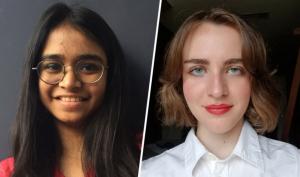
Young scholars from around the world who use machine learning and artificial intelligence tools to accelerate the search and discovery of new materials are embracing the chance to learn and share their work through the Materials Informatics Research Group at the University of Virginia School of Engineering and Applied Science.
Because computational tools and models can be developed on a remote environment and shared outside the lab, the group — led by Prasanna Balachandran, assistant professor of materials science and engineering and mechanical and aerospace engineering — presents a unique outreach opportunity to students interested in learning more about materials science through internships and special projects.
“As a group, we are always in constant debate about how to make our research more impactful and visible to the broader society,” Balachandran said. “It is inspiring to see how our team has embraced the open philosophy of discussing and disseminating our research findings through innovative cyberinfrastructure tools.”
Sunidhi Garg participates in Balachandran’s group as a virtual intern while earning her degrees at the Birla Institute of Technology and Science, Pilani, one of India’s top colleges in engineering. Garg was led to the group through a course assignment to engage a materials scientist anywhere in the world and from advice she received from friends enrolled at UVA.
Garg — who is working toward a bachelor’s degree in chemical engineering and a master’s in mathematics on the Pilani, India, campus — supported the research group’s search for new solid-state refrigerants, advancing UVA Engineering’s creation of more durable and sustainable platforms for energy and water use.
HVAC equipment accounts for between 35% and 40% of primary energy consumption in U.S. residential and commercial buildings. Vapor compression systems are one of the dominant technologies for space cooling. Unfortunately, low-performance conventional fluorocarbon refrigerants — the working fluid of the system — have a high global-warming potential. Many of these compounds are banned in new appliances; others are being phased out under U.S. Environmental Protection Agency regulations.
Garg worked with UVA group members who use mathematical and machine learning models to predict novel solid-state electrocaloric materials that could serve as nontoxic and environmentally friendly alternatives to harmful chlorofluorocarbons and hydrochlorofluorocarbons.
Alongside Melody Su, a third-year student of computer science, and Ryan Grimes, a Ph.D. student of materials science and engineering, Garg helped launch an open-access web application called Electrocalorics, which allows users to predict the material’s potential to be a good refrigerant. Su developed the machine learning model that drives the application, and Garg designed the user interface.
“Sunidhi’s app is interactive — researchers can plug in the compositions of a compound and get a really good sense of the material’s performance as a solid-state refrigerant, even before this material is made,” Balachandran said. “The open-access nature of the app enables our work to be shared with the world, which we hope will be beneficial to the researchers for making informed decisions and accelerate the whole process from design to fabrication.”
Garg said that while working with Balachandran’s group, she was able to apply course work in numerical modeling for chemical engineering and math to an actual research project.
“Learning the R-Shiny language for data science and data analytics will be very helpful to me in the future,” said Garg, who expects to continue her engagement with Balachandran’s group members as her studies at BITS Pilani allow.
Garg’s internship experience — gaining a breadth of knowledge and the satisfaction that comes from making substantive progress toward a societal challenge — is something Balachandran said he wishes for all his group members.
Paige Delsa discovered Balachandran’s research while searching for programs that would supplement her online learning at the Louisiana School for Math, Science and the Arts during her senior year.
Delsa, who is from Mandeville, Louisiana, first learned about artificial intelligence through a summer 2020 program sponsored by the North Carolina School for Science and Mathematics. North Carolina State University hosted her work with materials scientists, computer scientists and biologists in its bio-informatics laboratory.
“Materials science combines math, physics, chemistry, computer science — that’s part of the reason why I really like Professor Prasanna’s work,” Delsa said. “Materials science blends these perfectly in an engineering way, to see impacts in a relatively short period of time.”
Delsa began contributing to Balachandran’s group in August 2020. Like Garg, Delsa has developed R-Shiny web applications, such as Artificial Intelligence Research for High Entropy Alloys Design, to make the group members’ models more digestible and interactive. More recently, she helped train a model to classify images collected through optical microscopy. She is conducting a literature review to see whether materials scientists can productively adopt reinforcement learning algorithms used in chemistry, biology and computer science.
Delsa is carrying what she learned into her undergraduate program at the University of Richmond, where she will likely major in physics or computer science. She said she will keep materials science on her radar as she makes progress toward a graduate degree and a career as a research scientist.
“My interaction with Professor Prasanna’s group members, seeing how well they work together, has strengthened my interest in science,” Delsa said. “Even though there’s always a push to move forward, it never feels like we are competing with each other. It feels like we are very supportive and collaborative.”